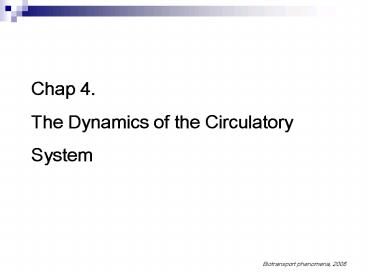Chap 4' - PowerPoint PPT Presentation
1 / 28
Title:
Chap 4'
Description:
I. General Structure, Volumes, ... Heart 250 ml, Unaccounted 550 ml (probably extra blood in reservoir of ... B: isometric(isovolumetric) contraction phase. C: ... – PowerPoint PPT presentation
Number of Views:22
Avg rating:3.0/5.0
Title: Chap 4'
1
Chap 4. The Dynamics of the Circulatory System
2
I. General Structure, Volumes, and Flow Rates
Approximate Estimate of Blood Distribution in
Vascular Bed of a Man
3
Blood Flow to Different Organs and Tissues under
Basal Conditions
4
I. General Structure, Volumes, and Flow Rates
Systemic Circulation of a Dog
assuming blood viscosity is 0.03P
5
(No Transcript)
6
Systemic Circulation of Man
assuming blood viscosity is 0.035P
7
II. Capillary Blood Flow
Let
Capillary diameter 8 mm The number of systemic
capillaries in body 109 Cardiac output 5
liters/min
The linear velocity of blood flow in the
capillaries is
Assuming each capillary is 1mm long, the bloods
residence time is
so little time for exchange
extremely efficient mass transfer in the
capillaries
8
III. Rates of Shear in the Circulation
Rates of shear in the circulation
assuming blood viscosity is 0.03P
9
IV. Pressure profiles in the circulatory system
10
Diagrammatic comparison of the behavior of the
pressure and flow pulses in the systemic arteries
p78
Note that the pressure pulse increases and the
flow pulse decreases.
11
Peripheral resistance
Peripheral resistance
Relative resistance to flow in the vascular bed
12
V. Interconversion of pressure and kinetic
energy in the circulation
Kinetic energy ? pressure
? 1/2 for laminar ? 1 for turbulent ? 1/2
1 for transition
13
V. Interconversion of pressure and kinetic
energy in the circulation
Amount and relative importance of kinetic energy
in different parts of the circulation
14
A. Kinetic Energy Effects in Narrowed Arteries
- Stenosis narrowed arteries due to fatty deposits
15
A. Kinetic Energy Effects in Narrowed Arteries
- Stenosis
Let
Then,
Thus,
By the Bernoullis equation (law of energy
conservation)
Cave in at the stenosis
Due to the significant increase of the peripheral
resistance
Causing the flow to slow down
Decrease in KE
Increase in pressure
Periodic closing and opening flutter
16
A. Kinetic Energy Effects in Narrowed Arteries
- Pressure rise in an aneurysm
17
Ruptured AAA
Un-ruptured (control) AAA
18
(No Transcript)
19
Fluid-Structure Interaction in Aneurysm
20
A. Kinetic Energy Effects in Narrowed Arteries
- Pressure rise in an aneurysm
Let
Then,
Thus,
By the Bernoullis equation (law of energy
conservation)
Arterial rupture
21
VI. Mechanical Energy Balance
Bernoulli equation
22
VI. Mechanical Energy Balance
A. Horsepower of the heart
- Assuming
- Cardiac output 5 liter/min
- (b)
- (c)
- (d) KE can be neglected
6mmHg
15mmHg
95mmHg
0mmHg
13.8 of basal metabolic rate of 72kcal/hr
23
Pressure-volume diagram for the left ventricle of
the heart
Work done by the LV on the blood
Work done by the blood on the LV
Net mechanical work of the LV in one cycle
A filling phase B isometric(isovolumetric)
contraction phase C ejection phase D
isovolumetric relaxation phase E complete cycle
24
B. Friction losses in the circulation
Inlet and outlet are adjacent
Thus,
- Work is done by the heart in order to overcome
frictional energy losses. - Hearts work total frictional loss
25
C. Hydrostatics of the circulation
Hydrostatic pressure
collapsed
26
Distensibility of the vein
artery
vein
27
(No Transcript)
28
Artery and vein































